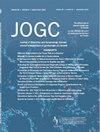Provider Perspectives on Intrauterine Device Practices in Adolescent Patients
IF 2.2
Q2 OBSTETRICS & GYNECOLOGY
引用次数: 0
Abstract
Objectives
Adolescent pregnancy is a worldwide public health concern, and the intrauterine device (IUD) is known to be a safe and effective method of long-acting reversible contraception in this group. Pediatric and gynaecologic societies have recommended the IUD as a first-line contraceptive for adolescents, given its safety and efficacy. This study aims to understand current IUD practices and elucidate barriers to insertion.
Methods
A survey was disseminated to North American Society for Pediatric and Adolescent Gynecology members via the listserv on 2 separate occasions. Consent was obtained prior to initiation of the survey. Results from the survey were anonymous and tabulated using descriptive statistics. Ethics approval was obtained (REB22-0269).
Results
There were 55 respondents, mostly in North America (93%). According to providers, adolescents most frequently seek out the IUD for contraception (45%) and abnormal uterine bleeding (24%). Providers felt the most common barriers were misconceptions (25%) and pain with insertion (24%). Although many physicians perform office insertions, several found that a Procedural Sedation Centre optimized wait times (38%) or felt that such a centre would be helpful (33%).
Conclusions
This study demonstrated that misconceptions surrounding the IUD remain. Education on contraception, specifically long-acting reversible contraceptives, is pivotal in decreasing adolescent pregnancy, reducing barriers, and improving adolescents’ attitudes toward the IUD. Pain with insertion is a limiting factor, and procedural sedation may help in managing expectations and increasing acceptance.
提供者对青少年患者宫内节育器实践的看法。
目的:青少年怀孕是一个全球性的公共卫生问题,而宫内节育器(IUD)被认为是这一群体安全有效的长效可逆避孕方法。鉴于其安全性和有效性,儿科和妇科协会建议将宫内节育器作为青少年的一线避孕措施。本研究旨在了解目前的宫内节育器的做法,阐明插入的障碍。方法:在两个不同的场合通过列表服务向NASPAG(北美儿科和青少年妇科医师协会)成员分发调查问卷。调查开始前已取得同意。调查结果是匿名的。结果用描述性统计数据制成表格。获得伦理批准(REB22-0269)。结果:共有55名受访者,大部分来自北美(93%)。根据提供者的数据,青少年最常寻求使用宫内节育器避孕(45%)和子宫异常出血(24%)。提供者认为最常见的障碍是误解(25%)和插入疼痛(24%)。尽管许多医生执行办公室插入,但许多医生发现程序镇静中心优化了等待时间(38%)或认为这样的中心会有所帮助(33%)。结论:本研究表明围绕宫内节育器的误解仍然存在。避孕教育,特别是LARCs,对于减少青少年怀孕、减少障碍和改善青少年对宫内节育器的态度至关重要。插入时的疼痛是一个限制因素,程序性镇静可能有助于控制预期和增加接受度。
本文章由计算机程序翻译,如有差异,请以英文原文为准。
求助全文
约1分钟内获得全文
求助全文
来源期刊

Journal of obstetrics and gynaecology Canada
OBSTETRICS & GYNECOLOGY-
CiteScore
3.30
自引率
5.60%
发文量
302
审稿时长
32 days
期刊介绍:
Journal of Obstetrics and Gynaecology Canada (JOGC) is Canada"s peer-reviewed journal of obstetrics, gynaecology, and women"s health. Each monthly issue contains original research articles, reviews, case reports, commentaries, and editorials on all aspects of reproductive health. JOGC is the original publication source of evidence-based clinical guidelines, committee opinions, and policy statements that derive from standing or ad hoc committees of the Society of Obstetricians and Gynaecologists of Canada. JOGC is included in the National Library of Medicine"s MEDLINE database, and abstracts from JOGC are accessible on PubMed.
 求助内容:
求助内容: 应助结果提醒方式:
应助结果提醒方式:


